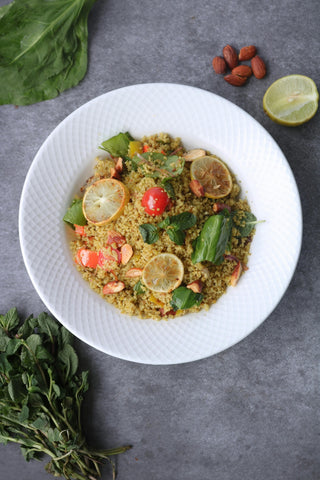You'll see almost all social media and the internet suddenly blowing up about why whole grains are so important for our health. Do you know what the fuss is about? Well, I don't know why it has become a topic of conversation all of a sudden, but I do know that whole is the kind of grain that I was mostly fed by my Mom and Grandma growing up, and I have many fewer lifestyle health issues (like high blood sugar, high blood pressure, bad cholesterol, daily gut issues, etc.) compared to a lot of people I know in their mid-40s (touchwood!). So, I will just speak to my experience with whole grains and the ancient wisdom my Mom and Grandma passed on to me.
Whole Grains vs. Refined Grains
First off, just in case you don't already know what whole grains are, whole grains mean that the grain has the entire grain – the bran, the germ, and endosperm. This is different from what you'd usually find in a refined grain, which only has the endosperm. You may ask what endosperm is. In simple terms, it is the starchy part of the grain that gives the max carbohydrate content from the grain. The bran and germ, on the other hand, are rich in fiber, vitamins, and minerals. I am sure this gives you an idea of why whole grains are better for your health!
Because of the fiber and other nutrients that the bran and germ contain, whole grains that contain all three essential components of the grain provide a broader range of health benefits, including improved digestive health, better regulation of blood sugar levels, and a better supply of nutrients.
Examples of Whole Grains
While the term 'whole grains' may sound fancy and sophisticated, it is not that hard to find them or products made with whole grains if you look a bit beyond a big supermarket or a convenience store.
There are many kinds of whole grains or pseudo-grains that you can choose from. Here's a quick list:
Whole Wheat
When choosing flour or a prepared food product, look at the ingredients list to see if it says 'whole wheat' or 'whole wheat flour' (as opposed to just 'wheat'). Your local farmers' market or a small health food store that works with local mills and farmers is a better bet because you are closer to the origin of the product and the source of information. Pro tip - prefer an ancient variety of wheat such as Einkorn, Emmer, Khorasan if wheat gives you gut issues. These ancient grains are not genetically modified, unlike the modern-day wheat that’s been hybridized for more yield.
Quinoa
Technically, Quinoa is not a grain (it is a seed), but it is used as a traditional grain. It is a really good source of protein, fiber, iron, magnesium, and amino acids. Quinoa can easily replace white rice. If you love white rice too much but still want to make a shift to whole grains, try mixing up white rice with Quinoa in equal proportions and add a bit of Ghee (clarified butter) to it. Works pretty well for me!
Brown Rice
The bran and germ layers of brown rice are a good source of fiber and B vitamins. It tastes much less sweet than white rice and can be a bit hard to digest, though. So, give it a pass on the days when your digestion is already slow.
Millets
Again, these are small-seeded grasses. Growing up in India, we had a whole variety of millets like Pearl millet, Finger millet, Kodo millet, Little millet, etc. If you are looking for a locally grown millet in the US, try the Proso millets, Sorghum, or Amaranth. Millets cannot be milled but whole. So, when you buy millet seeds or flour, you are buying the whole grain by default.
Millets can be drying, so make sure you add a bit of good fat to it when you consume – Olive oil or Ghee are my first choices for good fat, and they flavor the millets beautifully. In case you feel constipated often, you might want to give millets a pass.
When you consume millets, also remember you are doing Mother Earth a favor. Millets are a crop that actually enhances the nutrient quality of the soil and makes a very important cover crop!
Others
There are many other whole grains that we aren’t covering here like Barley, Buckwheat, etc.
All of these whole grain options are plant-based and hence, a good nutritious option for people following a vegan diet.
You might wonder if whole grains are gluten-free. Well, not all of them. For people looking for gluten-free whole grains, Quinoa, Brown Rice, and Millets are a great option.
How to Use Whole Grains
There are limitless possibilities. Let’s touch on a few briefly here:
Whole Wheat Flour
Typically, you can replace all-purpose flour or refined wheat flour with whole wheat flour in a 1:1 ratio in baking recipes. Some varieties of wheat might need minor adjustments, e.g., Einkorn whole wheat flour needs lesser hydration than other wheat varieties. Also, whole wheat will add a depth of flavor to your recipes. Some of the ancient wheat varieties have a slightly nutty flavor. Try our Einkorn Cookies to experience the goodness of whole grain Einkorn wheat.
Whole Grain Salads
Quinoa and Farro are whole grains that make an excellent base for a salad. Add some seasonal veggies, some olive oil and lemon, and that’s all. Good ingredients don’t need much to make a delicious meal. Agree?

Whole Grain Bowls
Quinoa, Farro, Brown rice, and Millets, all make a good base for a warm lunch bowl. Add some veggies, lentils stew, some curried tofu, or whatever you’d like on top of it. To season the whole grain, add some good fat, salt while they boil. You can add some herbs like Rosemary, fresh Cilantro, Oregano, Black Pepper as well.
Breakfast Porridge
Instead of having a store-bought cereal in cold milk, try a warm porridge with boiled Amaranth. Boil the Amaranth seeds (water is usually 3 times the grain and needs about 20-30 minutes of boiling. Slow cookers work well). Add some dates or raisins to sweeten while you boil to sweeten the porridge. Once the grains boil, add some milk (almond or dairy both work), add some nuts, and your warm whole grain porridge, without any refined sugar, is ready!
Whole grains for a balanced meal
All in all, whole grains make a delicious yet better-for-you meal. They give you more nutrition, extra flavor, and a better gut! I kinda understand why people are trying to revive the knowledge. Try the whole grains yourself, experience what they do for your body and taste buds! We hope you live balanced, live well.

